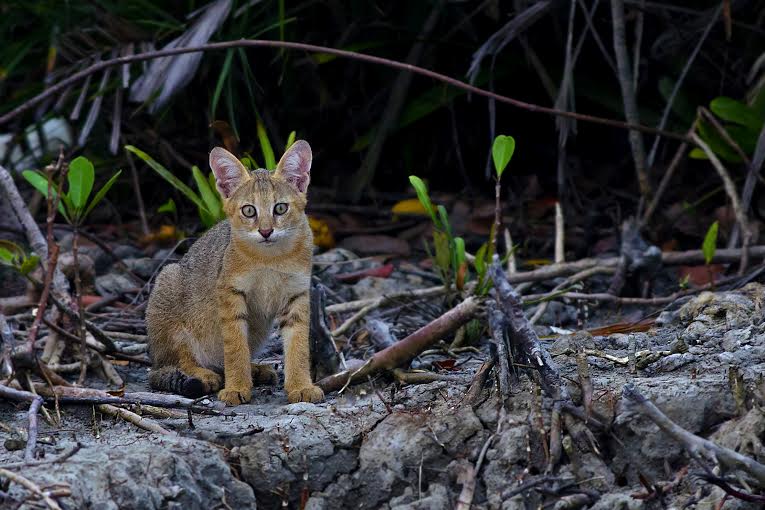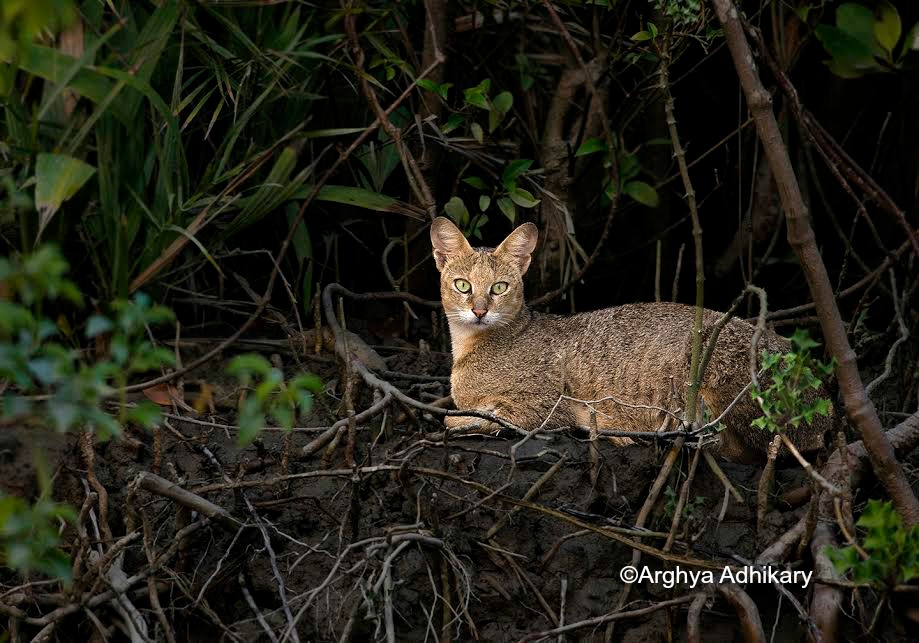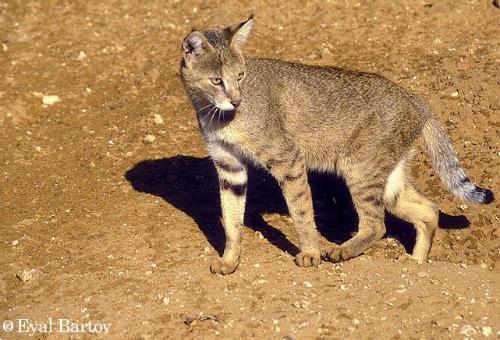- HB Length: 58-76 cm (23-30″)
- Tail Length: 21-27 cm (8-11″)
- Height: 35-38 cm (14-16″)
- Weight: 5-9 kg (11-20 lbs)
- Pop. Trend: Decreasing
Jungle Cats Felis chaus are not actually associated with ‘jungles’, but with dense vegetative cover surrounding wetlands. They are more commonly known as Swamp Cat or Reed Cat.
The coat colour of the Jungle Cat varies from a sandy or yellowish grey, to a greyish brown or tawny red above, with underparts of the slender body cream or pale rufous. The legs sometimes retain some faint horizontal striping, not completely faded from their younger days. Their head is rather narrow and has a high, domed forehead. Ears are tall and rounded, tipped with small tufts of black hair, and set fairly close together. The eyes have bright yellow irises. Their legs are long and slender, and the tail is comparatively short, with several dark rings and a black tip. Melanistic individuals have been found in Pakistan and India.
Distribution

Jungle cats have a broad but patchy distribution from the Nile River Valley in Africa, to India and southern Asia, and throughout tropical China and Southeast Asia. They are most commonly found at elevations below 1,000 metres, but have been recorded in the Himalayas at 2,400 metres. Jungle cats have also been recorded well into mountainous areas in Tadzhikistan, but were always found along densely vegetated river valleys.
Their preferred habitat is the tall grasses, reed beds or thick brush surrounding wetlands which is prime rodent habitat. These areas are found in a variety of ecosystems including desert oases or along riverbeds in grasslands, scrub or deciduous forests.
These adaptable cats can do well in cultivated landscapes and forest plantations with artificial wetlands. They have been found in association with man-made fish ponds, reservoirs and sprinkler-irrigated landscapes.
Ecology
Jungle Cats feed on a wide variety of prey species reflecting the variety of habitats they frequent, but small rodents are the main prey. A field study in India estimated one cat could catch 3 to 5 rodents per day, with birds ranking second in importance. They were also seen scavenging kills of large predators.
These cats are excellent swimmers, and have been observed diving into shallow water for fish. In southern Russia waterfowl was found to be the mainstay of their diet in the winter months. The Russian study also showed that olives made up 17% of their diet.
Jungle Cats frequently use the abandoned burrows of other carnivores such as foxes and badgers as den sites. Known to be active by day and by night, they are often spotted amidst human settlements, denning in old buildings.
Reproduction
They are thought to be polyestrous throughout the year. Mating occurs in February and March in Central Asia but May is thought to be the chief mating season in India. Kittens have been found in Assam in January and February, and in June in the west Caspian region. It is possible that the jungle cat breeds twice a year in productive habitat. One to six kittens are usually born in den sites located in dense reed beds or other thick vegetation, also in hollow trees or abandoned burrows. The kittens are born with black stripes that fade with age. They weigh 130 – 140 grams at birth and their eyes open at 10 – 12 days. They are weaned at three months, stalk and kill prey by five to six months (are independent at this time), and are sexually mature between 11 and 18 months of age. Captive individuals have lived to 15 years old. The Jungle Cat was once fairly common in zoos but their numbers are now dwindling.
Conservation
These cats are reliant on healthy wetland systems so the ongoing reclamation and destruction of natural wetlands poses a serious threat to the species. Jungle Cats are widespread and common in some parts of their range, but in Egypt and many parts of Asia their populations are showing sharp declines. Trapping, snaring and poisoning have also caused population declines in many areas throughout their range.
In India, local tribesmen easily identify the Jungle Cat from photos, and describe it as part of their wild meat diet. It is considered a delicacy and found more regularly on the menu than other wild cats in the area.
These cats share the distinction with African Wildcats Felis silvestris and domestic cats of having been mummified and placed in tombs in ancient Egypt. They are also depicted hunting small birds and mammals in Egyptian wall paintings.
Range Map IUCN Red List 2008
Updated 2014




Pat Bumstead
The information on all our fact sheets comes from The World Conservation Union Cat Specialist Group – http://www.catsg.org/index.php?id=114 If you scroll down the page, their list of References is shown at the bottom.
Kishore Raj D
Hello, This is really interesting and It will be really great if you also please provide the references from which you derived these information?
Pat Bumstead
Because these cats range over so many countries, no one has any idea how many there are. They are thought to be common in India, but now rare in Russia, for example. It is pretty safe bet to say their populations are declining through human activities though, as are all the small wild cats.
Andy
Do you know how many Jungle Cats left in the world?
Pat Bumstead
Jungle cats have not migrated from Asia to the USA but there are a few private breeders that cross them with domestic cats to make a new breed. Jungle cats have a very plain coat though, with no stripes or markings except on their legs and tail.
Marie
Is it at all possible that the jungle/swamp cat has migrated to or been brought to the USA? My cat had kittens and between 2 liters 4 have come out looking just like the beautiful babies, only to change colors and marking before a year old. 3 are the tan shade and the other is a greyish white with dark stripes. We knew from birth these were like any other babies we had ever had or seen. I just saw an article on facebook today and am curious.